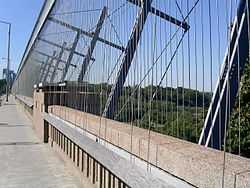Luminous Veil


The Luminous Veil is a suicide barrier that was added to the Prince Edward Viaduct in Toronto, Ontario, Canada. First approved by the Toronto City Council in 1998, the construction of the Luminous Veil was delayed for years because of concerns about funding. During the delays in construction, the viaduct was the site of an estimated 60 suicides.[1] The city council originally approved a C$2.5 million budget for the Luminous Veil. However, the minimum bid for construction was $5.5 million. After a year's delay, they endorsed a fundraising campaign to raise the rest of the money.[2] Construction was completed in 2003 at the cost of $5.5 million, with $2.5 million coming from taxpayers.[2]
The Luminous Veil was designed jointly by architect and University of Waterloo Professor Derek Revington and engineers at Halcrow Yolles, a structural engineering firm in Toronto. It consists of over 9,000 rods, each 5 metres (16 ft) tall, spaced 12.7 centimetres (5.0 in) apart and held in place by an angled steel frame.[1] The tensile structure was difficult to analyze and required several tests at the University of Toronto. The design, which is an effective suicide barrier without significantly disrupting the view from the viaduct, won the 1999 Canadian Architect Award of Excellence.[3] Cost prohibited the planned lighting to be installed on the top horizontal member, but the name "Luminous Veil" continues to be used.
While the Luminous Veil appears to have had the intended effect of preventing suicides on the Prince Edward Viaduct, it has had no appreciable effect on the total number of suicides in Toronto.[1]
References
Coordinates: 43°40′31″N 79°21′50″W / 43.67528°N 79.36389°W